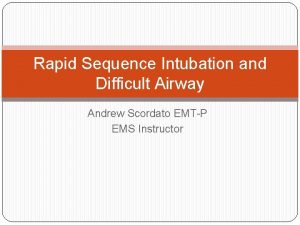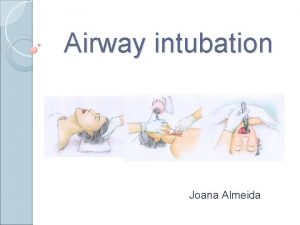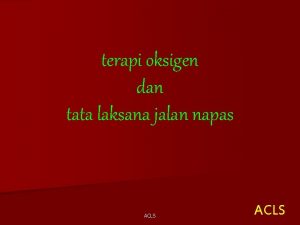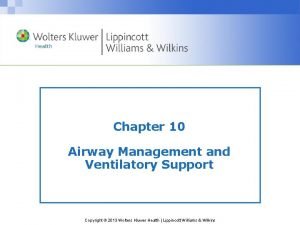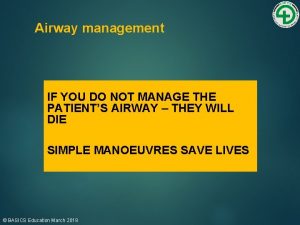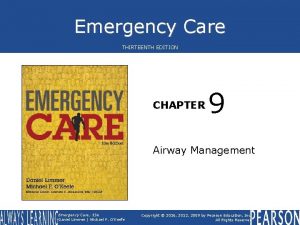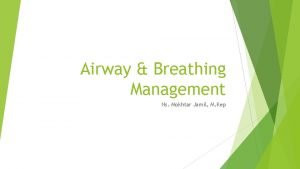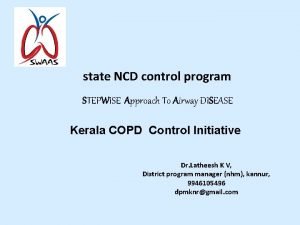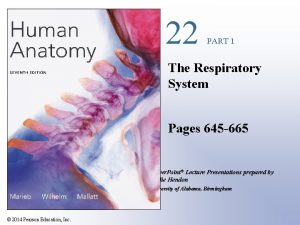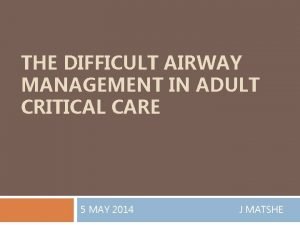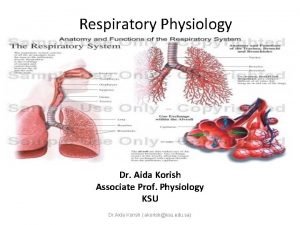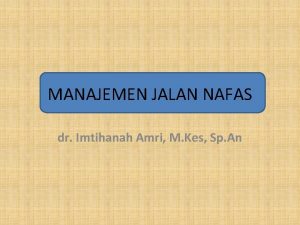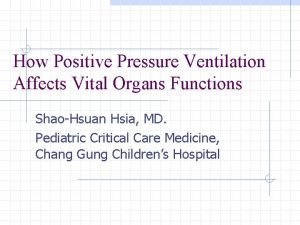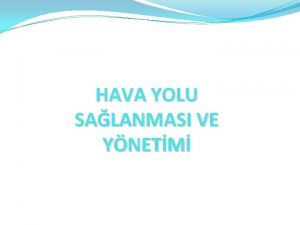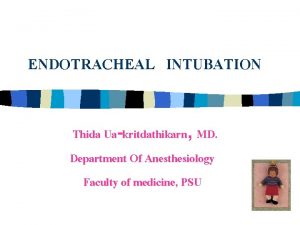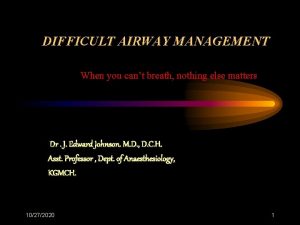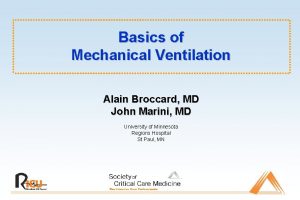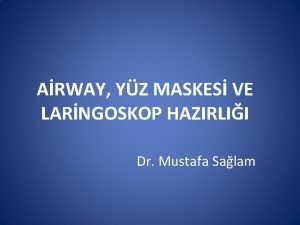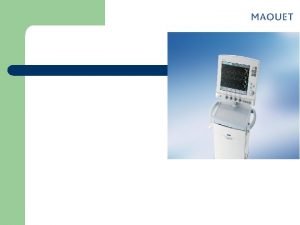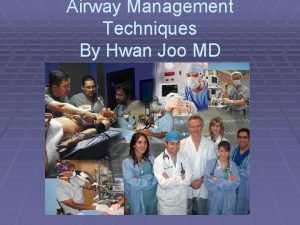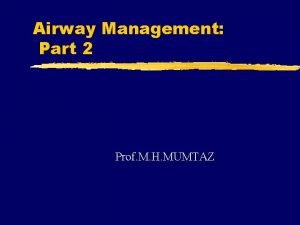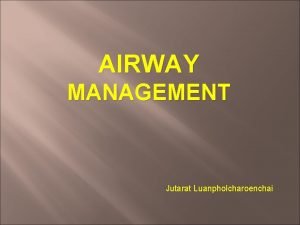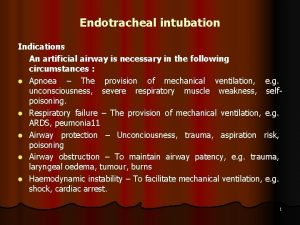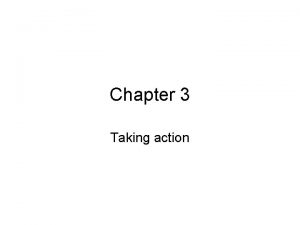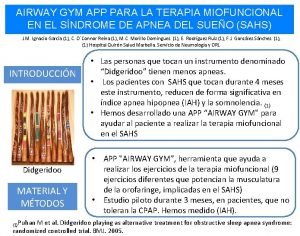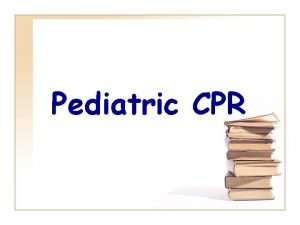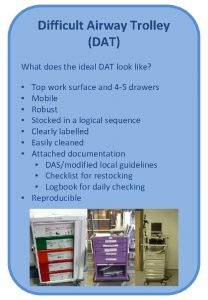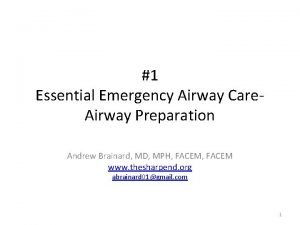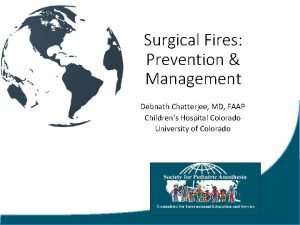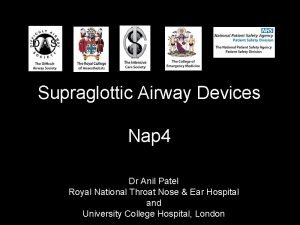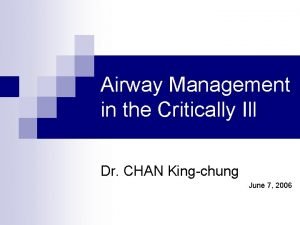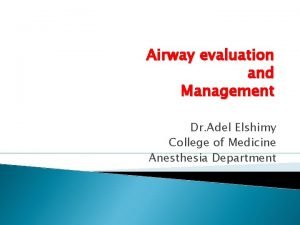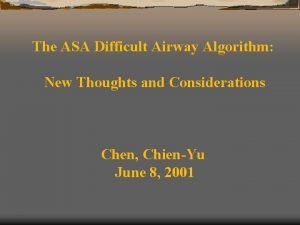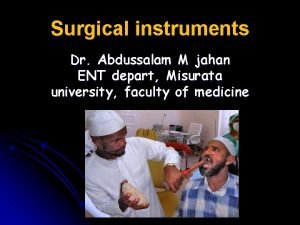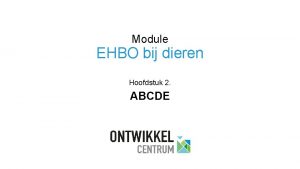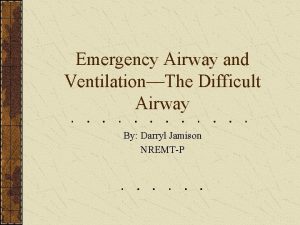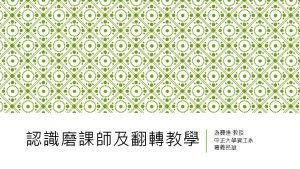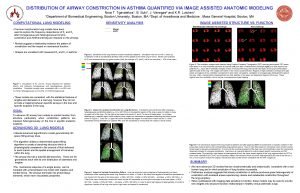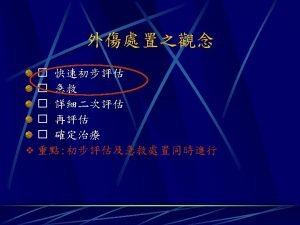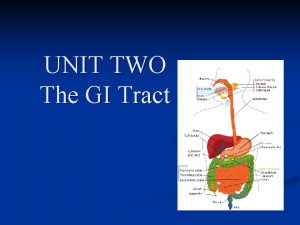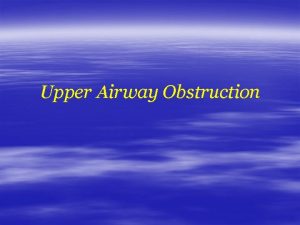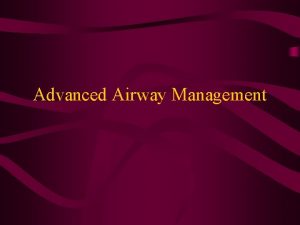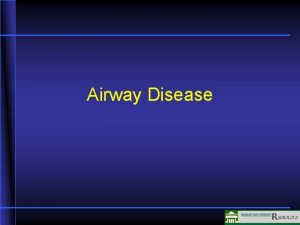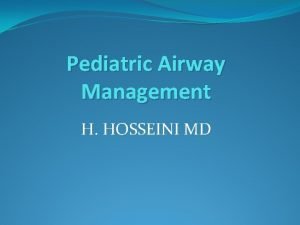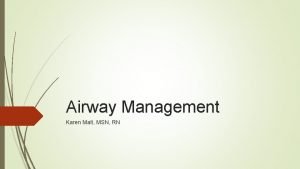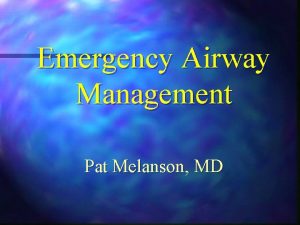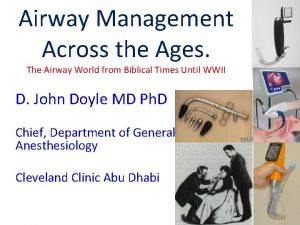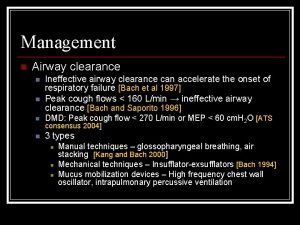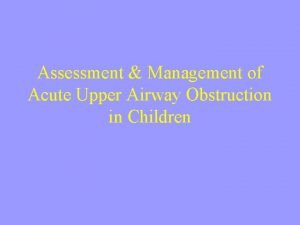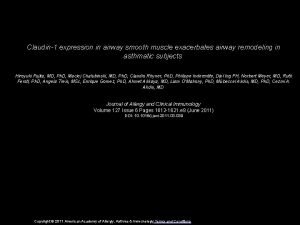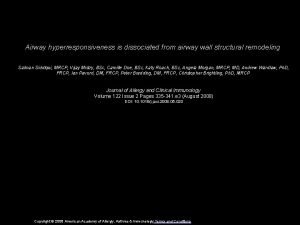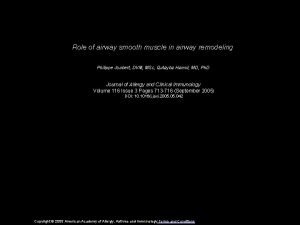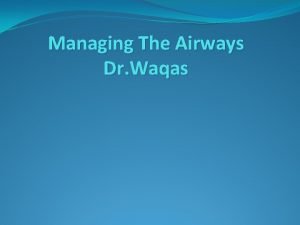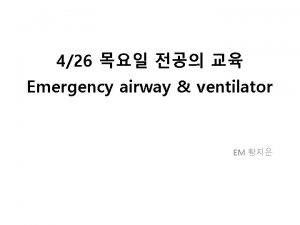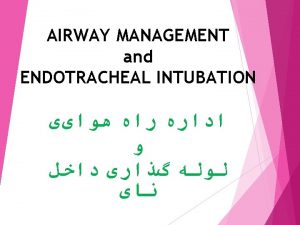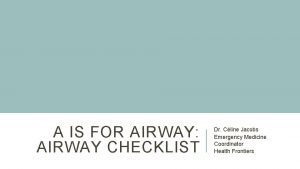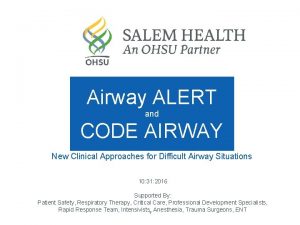Airway Management Anatomy Review Anatomy of the Upper




































































- Slides: 68

Airway Management


Anatomy Review


Anatomy of the Upper Airway

Internal Anatomy-Upper Airway

Internal Anatomy-Upper Airway

Start with the Basics �Start with the simple steps ◦ Positioning - Clear the airway ◦ Nasal adjuncts ◦ Oral adjuncts ◦ BIAD (AKA: Blind Insertion Airway Devices) ◦ Intubation ◦ Cricothyrotomy

Airway Maneuvers

Head-Tilt Chin-Lift

Head-Tilt Chin-Lift �Indication ◦ Without suspected spinal injury ◦ Unresponsive patient that can not protect their own airway ◦ Simple, safe and non-invasive ◦ Does not protect from aspiration

Head-Tilt Chin-Lift �Method ◦ Tilt head back with hand on patient’s forehead ◦ Fingers of other hand under bony part of lower jaw and lift chin forward ◦ AHA standard for non-injury patient

Head-Tilt Chin-Lift Maneuver

Jaw Thrust

Jaw Thrust �Indication ◦ Used in suspected spinal injury/history of cervical injury or fusion, etc �Method ◦ Grasp angle of lower jaw ◦ Lift with both hands and displace mandible forward while tilting the head back

Jaw Thrust Maneuver

Airway Adjuncts

OPA �Indications ◦ Hold tongue away from the posterior wall of the pharynx ◦ Unconscious, semi-conscious without a gag ◦ Infant to adult sizes

Oropharyngeal Airway

OPA �Method ◦ Measure ◦ Clear airway ◦ Upside-down or at 90 -degree angle ◦ Rotate until against posterior wall of oropharynx ◦ Confirm placement

OPA �Disadvantages ◦ Does not protect from aspiration ◦ May stimulate vomiting and laryngospasm if gag present ◦ If not inserted properly, pushes tongue back and causes airway obstruction

Measuring an OPA

Inserting OPA

Nasopharyngeal Airways

NPA �Indications ◦ Semiconscious or patient unable to maintain own airway ◦ Unconscious where OPA not used ◦ Seizures ◦ C-spine Injury ◦ Before nasotracheal intubation ◦ Guide for inserting a nasogastric tube

NPA �Advantages ◦ Well tolerated in those with a gag reflex ◦ Inserted rapidly ◦ Used when OPA is contraindicated (facial trauma, gag reflex)

NPA �Disadvantages ◦ Longer length may enter esophagus ◦ Laryngospasm and vomiting ◦ Injury to nasal mucosa, bleeding, or obstruction ◦ Small diameters can become obstructed with vomit, mucus, or blood ◦ Does not protect from aspiration ◦ Can’t suction through

NPA �Method ◦ Measure ◦ Lubricate with water-soluble lubricant ◦ Bevel tip toward nasal septum ◦ Use natural curvature of nasal passage ◦ Should rest in posterior pharynx

Measuring a Nasal Airway

Bag-Valve Mask

BVM �Indications and Advantages ◦ Self-inflating and non-rebreathing ◦ Use with airway maintenance device ◦ Use with apnea or ineffective effort ◦ Provides blood/body fluid barrier ◦ Room air (21%) to 100% Fi. O 2 ◦ Sense of lung compliance

BVM �Disadvantages ◦ Difficult to master – tidal volume dependent on mask seal ◦ Inadequate tidal volume from poor technique, poor mask seal, and gastric distention

BVM �Method ◦ Position at patient’s head ◦ Clear airway ◦ Head tilt chin lift or jaw thrust ◦ BLS or ALS airway ◦ Tight seal on mouth with E-C positioning ◦ One and two person options

BIADs

Laryngeal Mask Airway: LMA Forms low pressure seal over laryngeal inlet

LMA �Indications ◦ Situations involving a difficult mask fit ◦ Cannot be intubated, can be ventilated ◦ ETT can be passed through LMA ◦ May be used as a “second-last-ditch” airway where a surgical airway is the only remaining option

LMA �Contraindications ◦ Cannot open mouth ◦ Airway obstruction or abnormalities ◦ High risk of aspiration (obesity, late pregnancy, not NPO, etc)

LMA �Method ◦ Have all equipment ready, select appropriate size (sizes 1 -5) ◦ Test cuff inflation/deflation system (reference point: Size 4 (adult)-30 ml) ◦ Apply a water-soluble lubricant to the back of the mask

LMA � Method ◦ Grasp the LMA by the tube, holding it like a pen as near as possible to the mask end. ◦ Place the tip of the LMA against the inner surface of the patient’s upper teeth

LMA � Method ◦ Under direct vision press the mask tip upwards against the hard palate to flatten it out ◦ Using the index finger, keep pressing upwards as you advance the mask into the pharynx to ensure the tip remains flattened and avoids the tongue

LMA � Method ◦ Keeping the neck flexed and head extended, press the mask into the posterior pharyngeal wall using the index finger

LMA � Method ◦ Continue pushing with your index finger and guide the mask downward into position.

LMA � Method ◦ Grasp the tube firmly with the other hand then withdraw your index finger from the pharynx ◦ Press gently downward with your other hand to ensure the mask is fully inserted

LMA � Method ◦ Inflate the mask with the recommended volume of air ◦ Do not touch the LMA tube while inflating unless the position is unstable ◦ The mask can rise up slightly out of the hypopharynx as it is inflated to find its correct position

LMA Placement

LMA �Method ◦ Attach to BVM ◦ Perform standard evaluation of lung sounds ◦ Insert a bite-block or roll of gauze to prevent occlusion of the tube should the patient bite down ◦ Secure with tape or ET tube holder

LMA �Helpful Tidbits ◦ If you can’t ventilate, remove it ◦ Avoid excessive lubricant on anterior surfaces ◦ Avoid LMA fold over

King Airway

Proximal Opening of Gastric Access Lumen Pilot Balloon Primary Ventilatory Opening Proximal Cuff Stabilizes tube & seals oropharynx Multiple Distal Ventilatory Openings Distal Opening of Gastric Access Lumen Bilateral Ventilation Eyelets Distal Tip & Cuff Anatomically shaped to assist in passage behind larynx and normally collapsed esophagus

King Airway Comes in 3 sizes: �#3: 4– 5 ft �#4: 5– 6 ft �#5: > than 6 ft

King Airway �Indications ◦ When tracheal intubation indicated, but unsuccessful or unavailable. ◦ Access to the patient is limited (e. g. , trauma patients, entrapment, etc. ). ◦ Difficult or emergent airways ◦ Cardiopulmonary arrest (optional).

King Airway �Contraindications ◦ Presence of gag reflex ◦ Caustic ingestion ◦ Obstructed airway ◦ Esophageal trauma or disease

King Airway �Method ◦ Have all equipment ready, select appropriate size (#3, #4, or #5) ◦ Test cuff inflation system for leaks ◦ Apply a water-soluble lubricant to the posterior distal tip of the device

King Airway �Method ◦ Hold King Airway in dominant hand at proximal connector ◦ Perform tongue-jaw lift while keeping head in a neutral position

King Airway �Method ◦ Rotate King laterally 45 -90 degrees (blue orientation line is touching the corner of the mouth) ◦ Introduce tip into mouth and advance behind base of the tongue ◦ As the tube passes under the tongue, rotate the tube back to midline (blue orientation line faces chin)

King Airway �Method ◦ Advance tube until connector is aligned with teeth and/or gums.

King Airway �Method ◦ Using a syringe, inflate the cuffs with the appropriate volume of air. �#3: 45 -60 ml �#4: 60 -80 ml �#5: 70 -90 ml

King Airway �Method ◦ Attach BVM ◦ While ventilating, simultaneously withdraw until ventilation is easy and free-flowing. ◦ There should be good tidal volume with minimal resistance.

King Airway �Method ◦ Perform standard evaluation of lung ◦ sounds ◦ Attach and utilize end-tidal CO 2 monitoring ◦ Readjust cuff inflation as needed ◦ Consider securing with tape or ET tube holder

King Airway �Helpful Tidbits ◦ If you can’t ventilate, remove it ◦ If water soluble lubricant used, do not apply near ventilatory openings ◦ Be prepared to add another 10– 15 cc in the event of air leakage ◦ Insertion depth is critical

King Airway

ETTs

Endotracheal Intubation �Indications ◦ Respiratory or cardiac arrest ◦ GCS < 8 ◦ Risk of aspiration ◦ Obstruction due to foreign bodies, trauma, burns, or anaphylaxis. ◦ PTX or hemothorax with distress ◦ Need for mechanical ventilation

Endotracheal Intubation �Complications ◦ Equipment malfunction ◦ Teeth breakage and soft tissue lacerations ◦ Hypoxia ◦ Esophageal intubation ◦ Endobronchial intubation (right mainstem) ◦ Tension pneumothorax

Endotracheal Intubation �Advantages ◦ Isolates trachea and permits complete control of airway ◦ Impedes gastric distention ◦ Eliminates need to maintain a mask seal ◦ Offers direct route for suctioning ◦ Permits administration of some medications

Endotracheal Intubation �Disadvantages ◦ Requires training and experience ◦ Requires specialized equipment ◦ Requires direct visualization of vocal cords ◦ Bypasses upper airway’s functions of warming, filtering, and humidifying the inhaled air

Endotracheal Intubation �Method ◦ Pre-ventilate patient ◦ Position patient ◦ Assemble and check equipment ◦ Insert laryngoscope ◦ Visualize larynx and insert ETT ◦ Confirm placement ◦ Secure ETT

 Laryngoscopy view grades
Laryngoscopy view grades The upper airways
The upper airways Norwich terrier upper airway syndrome
Norwich terrier upper airway syndrome Intubation anatomy
Intubation anatomy Open the airway
Open the airway Endotracheal intubation indications
Endotracheal intubation indications Alveoli definition
Alveoli definition Indikasi intubasi
Indikasi intubasi Chapter 10 airway management
Chapter 10 airway management Airway ladder
Airway ladder Chapter 9 airway management
Chapter 9 airway management Basic airway management equipment
Basic airway management equipment Airway breathing management
Airway breathing management Stepwise airway management
Stepwise airway management Anatomy of the upper respiratory tract
Anatomy of the upper respiratory tract Respiratory system nasal cavity
Respiratory system nasal cavity Supratrochlear lymph nodes
Supratrochlear lymph nodes Thyromental distance
Thyromental distance Airway pathway
Airway pathway Respiratory airway secretary
Respiratory airway secretary Direct laryngoscopy view
Direct laryngoscopy view Pemasangan airway definitif
Pemasangan airway definitif Servo pressure on hfjv
Servo pressure on hfjv Mean airway pressure
Mean airway pressure Sellick manevrası
Sellick manevrası Mallampati score intubation
Mallampati score intubation Airway
Airway Larangoscopy
Larangoscopy Mean airway pressure formula
Mean airway pressure formula Ahi cpap
Ahi cpap 5 back blows
5 back blows Airway numaraları
Airway numaraları Asa classification
Asa classification Aprv waveform
Aprv waveform What is this picture from
What is this picture from Pharyngo-tracheal lumen airway
Pharyngo-tracheal lumen airway Head tilt chin lift jaw thrust
Head tilt chin lift jaw thrust Actual diagnosis
Actual diagnosis Indications for artificial airway
Indications for artificial airway What are the three emergency action steps
What are the three emergency action steps Airway gym app
Airway gym app A airway b breathing c circulation
A airway b breathing c circulation Ideal dat
Ideal dat Moans airway
Moans airway Silverstein fire risk assessment tool
Silverstein fire risk assessment tool Generations of supraglottic airway devices
Generations of supraglottic airway devices Nasopharyngeal airway
Nasopharyngeal airway Nasopharyngeal airway
Nasopharyngeal airway Asa difficult airway algorithm
Asa difficult airway algorithm Mouth gag airway
Mouth gag airway Open a casualty's airway
Open a casualty's airway Breathing abcde
Breathing abcde Lemon law airway
Lemon law airway Outside the classroom
Outside the classroom Noratbj
Noratbj Definitive airways
Definitive airways Gastinoma
Gastinoma Hình ảnh bộ gõ cơ thể búng tay
Hình ảnh bộ gõ cơ thể búng tay Bổ thể
Bổ thể Tỉ lệ cơ thể trẻ em
Tỉ lệ cơ thể trẻ em Chó sói
Chó sói Glasgow thang điểm
Glasgow thang điểm Bài hát chúa yêu trần thế alleluia
Bài hát chúa yêu trần thế alleluia Môn thể thao bắt đầu bằng từ đua
Môn thể thao bắt đầu bằng từ đua Thế nào là hệ số cao nhất
Thế nào là hệ số cao nhất Các châu lục và đại dương trên thế giới
Các châu lục và đại dương trên thế giới Công thức tính độ biến thiên đông lượng
Công thức tính độ biến thiên đông lượng Trời xanh đây là của chúng ta thể thơ
Trời xanh đây là của chúng ta thể thơ



